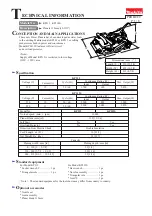
Electromagnetic Compatibility (EMC)
Service Manual
13-7
Note 1: At 80 MHz and 800 MHz, the higher frequency range applies.
Note 2: These guidelines may not apply in all situations. Electromagnetic propagation is affected by
absorption and reflection from structures, objects and people.
a
Field strengths from fixed transmitters, such as base stations for radio (cellular/cordless) telephones
and land mobile radios, amateur radio, AM and FM radio broadcast and TV broadcast cannot be pre-
dicted theoretically with accuracy. To assess the electromagnetic environment due to fixed RF trans-
mitters, an electromagnetic site survey should be considered. If the measured field strength in the
location in which the warming system is used exceeds the applicable RF compliance level above, the
warming system should be observed to verify normal operation. If abnormal performance is observed,
additional measures may be necessary, such as re-orienting or relocating the warming system.
b
Over the frequency range 150 kHz to 80 MHz, field strengths should be less than 3 V/m.
Table 13-4.
Recommended Separation Distances
Recommended Separation Distances Between Portable and Mobile RF Communications
Equipment and the Warming System
(IEC/EN 60601-1-2:2007, Table 6)
The warming system is intended for use in an electromagnetic environment in which radiated RF dis-
turbances are controlled. The customer or the user of the warming system can help prevent electro-
magnetic interference by maintaining a minimum distance between portable and mobile RF
communications equipment (transmitters) and the warming system as recommended below, accord-
ing to the maximum output power of the communications equipment.
Rated Maximum
Output Power (
P
) of
Transmitter in Watts
Separation Distance in Meters
150 kHz to 80 MHz
80 MHz to 800 MHz
800 MHz to 2.5 GHz
0.01
0.12
0.12
0.23
0.10
0.38
0.38
0.73
1.00
1.20
1.20
2.30
10.00
3.80
3.80
7.30
100.00
12.00
12.00
23.00
For transmitters rated at a maximum output power not listed above, estimate the separation distance
(
d
) using the equation in the corresponding column, where
P
is the maximum output [power rating
of the transmitter in watts (W)] according to the transmitter manufacturer.
Note 1: At 80 MHz and 800 MHz, the separation distance for the higher frequency range applies.
Note 2: These guidelines may not apply in all situations. Electromagnetic propagation is affected by
absorption and reflection from structures, objects and people.
d
1.2
P
=
d
1.2
P
=
d
2.3
P
=
Summary of Contents for WarmTouch
Page 1: ...Service Manual WarmTouch Convective Warming Unit...
Page 8: ...Page Left Intentionally Blank vi Service Manual...
Page 32: ...Page Left Intentionally Blank 1 18 Service Manual Introduction...
Page 42: ...Installation 3 4 Service Manual Figure 3 3 Power Cord Wrapped and Secured...
Page 45: ...Installing the Warming Unit Service Manual 3 7 Figure 3 5 Warming Unit Mounted on IV Pole...
Page 49: ...Installing the Warming Unit Service Manual 3 11 Figure 3 9 Warming Unit Mounted on Cart...
Page 50: ...Page Left Intentionally Blank 3 12 Service Manual Installation...
Page 70: ...Page Left Intentionally Blank 5 12 Service Manual Maintenance...
Page 84: ...Page Left Intentionally Blank 6 14 Service Manual Troubleshooting...
Page 105: ...Power Cord Replacement Service Manual 8 7 Figure 8 5 Power Cord Wrapped and Secured...
Page 118: ...Page Left Intentionally Blank 9 8 Service Manual Accessing the Inside of the Warming Unit...
Page 246: ...Enclosure Replacement 12 14 Service Manual Figure 12 10 Power Cord Wrapped and Secured...
Page 266: ...Page Left Intentionally Blank 12 34 Service Manual Enclosure Replacement...
Page 274: ...Page Left Intentionally Blank 13 8 Service Manual Product Specifications...
Page 313: ......
















































